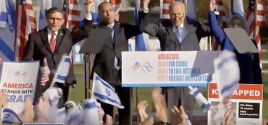Limits on access to oiled waters, coast frustrates journalistsBy Laura Maggi, The Times-PicayuneNOLA.com May. 31, 2010 |
Popular 
Sen. Hawley: Send National Guard to Crush Pro-Palestine Protests Like 'Eisenhower Sent the 101st to Little Rock'

Mistrial Declared in Case of Arizona Rancher Accused of Killing Migrant Trespasser

AP: 'Israeli Strikes on Gaza City of Rafah Kill 22, Mostly Children, as U.S. Advances Aid Package'

John Podhoretz Demands National Guard Be Sent Into Columbia U to Put Down Pro-Palestine Protests

House Passes $95B Foreign Aid Giveaway to Israel, Ukraine and Taiwan, Combined With TikTok Ban
 When a photographer from The Times-Picayune earlier this week tried to hire a plane to fly over Grand Isle, the charter plane company was told that the flight could not descend below 3,000 feet. Southern Seaplane owner Rhonda Panepinto said her husband called the BP Command Center on Tuesday for permission to fly photographer Ted Jackson over Grand Isle, so that he could take pictures of the impact of the spreading oil from the Deepwater Horizon well. But the plane company was told by a BP contractor that media flights weren't allowed in the restricted air space established by the Federal Aviation Administration. "They told him absolutely no media or press on any planes. The press flights are limited to Saturdays only and only in Coast Guard helicopters," Panepinto said. Southern Seaplane officials have complained about this restriction, as well as broader controls on their ability to fly other people into the "temporary flight restriction" area in the Gulf, to the FAA. The restricted area is large, including huge swaths of the coastline miles away from the Deepwater Horizon site. The 3,000-feet restriction means that photographers hiring private planes would have to fly so high they are unlikely to get clear photos of the ground. In a statement, the FAA maintains that BP employees or contractors are not calling the shots on who gets to fly into the restricted air space, saying those decisions are made by the FAA and Coast Guard. But agency spokespeople acknowledge that media access is limited, saying they are only allowing flights into the restricted area that are directly related to the disaster response. While news organizations won't be allowed to hire planes or helicopters, the FAA plans to arrange pool flights through the Coast Guard, said Laura Brown, the FAA's deputy assistant administrator for public affairs. Brown said there are normally 500 to 600 flights of either helicopters or planes in the area. Now, there are 800 to 1,000 flights in the same area, she said. Sporadic incidents of media outlets being blocked from access to oil-coated beaches or other areas have cropped up in recent weeks. A little more than a week ago, CBS Evening News aired a report showing BP contractors on a boat, along with two Coast Guard officials, who told a news crew to get off an oil-stained beach. "This is BP's rules, not ours," a man can be heard saying. The Coast Guard put out a statement by Lt. Commander Rob Wyman in response to that incident saying that there are no rules by either BP or the agency to "prohibit media access to impacted areas, and we are disappointed to hear of this incident." The Coast Guard, in fact, has given the media hundreds of opportunities to "embed" with boats and aircraft, the statement said. A Newsweek article posted online earlier this week quoted Associated Press photographer Gerald Herbert recounting a trip to the Breton National Wildlife Refuge with Jean-Michel Cousteau and Plaquemines Parish officials. When stopped by a Coast Guard boat, the party was denied access after learning that journalists were on board, according to the article. In an interview, Herbert said he spoke on Friday with Coast Guard Lt. Cmdr. Tony Russell, who said that if he was indeed turned away because he is a news photographer, that is not appropriate. Overall, Hebert said the Coast Guard has been "phenomenally helpful in getting access," routinely taking photographers up in helicopters and planes to get pictures.
|



